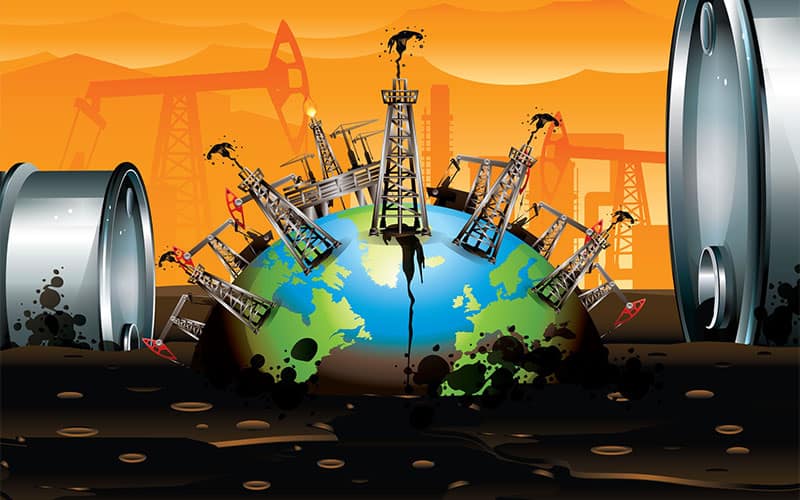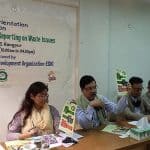Has there any success in stopping the Climate refugees’ procession?
Translated by: Zeba Tarannum
Original: Kamrul Islam Saikot
Do you feel the change in the crop cycle? Is there any change in biodiversity? Do Coral Jasmine flowers bloom on time? Is the seasonal winter bird coming on time? Are the autumn, late autumn missing from the seasonal cycle? Even not being an expert, I can feel the heat rising, increasing cold waves, and warming.

The sea-ocean is heating up, and saltwater is entering the coast. Cyclones, floods, droughts are frequently hitting. Every year we have a loss of 2-3 percent of the national income to protect, rehabilitation for this. Even then, the procession of climate survivors is getting longer.
Scientists are warning unless the carbon emissions are reduced, the whims of the weather will increase. According to them, the root cause of climate change is changing the capitalist consumer system. But that warning continues to be ignored. So the Carbon emissions continue to rise instead of decreasing.
According to the Paris Climate Agreement, global warming must be kept within a 1.5°C rise from 1750 to 2050. Who is listening? Many of the richest industrialized countries do not comply with the 1992 UN Climate Charter.

Trump did not obey, also greed others not to attend.
The hope is that the new US president Joe Biden has returned to the Paris Climate Agreement, changing Trump’s climate reluctance policy on his first working day. He believes in climate science. So, hopefully, significant changes are coming in world climate politics. We also need to be prepared.
Achieving the Sustainable Development Goal (SDG) by 2030 is just 9 years ahead. Climate is the 13th goal out of the 17 goals of the SDG’s. Adoption and mitigation of climate change under the Paris Agreement are 9 years on the way to achieve the goal. The question is, what will be the adaptation of this climate change?

What’s it different from normal development? It is still difficult to accurately measure adaptation in the context of climate change. However, science has so far identified three stages of adaptation. The first step is whether we are doing something that assesses and verifies potential adverse effects of climate change.
If we think so, we have to stop Climate change. For example, the Sundarbans must be protected at any cost. Because Sundarbans not only protect Bangladesh from cyclones, it also absorbs carbon. So the Sundarbans simultaneously adapt and mitigates climate change. Environmental destructive measures must be stopped.
Water, air and soil pollution must be prevented.
We are now in the second stage of adaptation. We also need to consider climate change while investing in long-term infrastructure such as bridges, roads, airports, seaports, etc. They do not provoke climate change and sustainability due to climate change effects in the future.
The issue is now being considered for investment in all major infrastructure projects globally. In Bangladesh, we also need to consider this. For example, it is better to reduce such climate risks if we build floating buildings on flooded land.
The third stage of adaptation is called transformational adaptation, which is still somewhat theoretical. There is no such good example yet. It is needed not only to address the risks of climate change but also to get the right results of adaptation.
However, an example can be given of how transformational adaptation can be. We need to invest in a dozen cities far from the coast by keeping in mind the inevitable displacement of millions of people of the coastal districts to become climate tolerant and immigrant-friendly cities.
Children in coastal areas need to be educated in such a way that they become skilled in urban work instead of being farmers or fishermen like their parents. This strategy will reduce the pressure on the capital Dhaka. This metropolis will not be able to accommodate another one-crore climate migrants in the next decade.
Bangladesh formulated the National Adaptation Action Plan (NAPA) in 2005 with funding from the Climate Charter. Later all the least developed countries prepared and implemented NAPA. In 2010, the National Adaptation Plan (NAP) was adopted in Cancun based on NAPA.
Several countries, including Nepal, have already made plans and are implementing them. In 2015, Bangladesh National Adaptation Plan made the first design. The work of formulating a national adaptation plan based on public participation needs to be completed quickly. Then we will be able to present the document at the World Climate Conference (COP 26) to be held in Glasgow, United Kingdom, from 1- 12 November 2021.
Bangladesh was the first country to adopt the Climate Change Strategy and Action Plan (BCCSAP) in 2008. After ten years, it now needs to be updated by domestic experts based on public participation.
In the meantime, we have gained some education and experience in making adaptation more effective. The first lesson is it will take a decade or more to achieve a genuinely transformative transformation. Investment in short and medium-term projects will not be suitable in this case.
This is a problem while using global funds such as the Green Climate Fund (GCF), which only finance projects. If they want to support transformational adaptation programs, they need to fund long-term program-based national programs.
The second lesson is – all the stakeholders of both inside and outside the government, especially the private sectors, need to be involved. The essential third lesson is that transformational change cannot be limited to small areas or sectors. It will have dimensions across the country.
Bangladesh was the first country to adopt the Climate Change Strategy and Action Plan (BCCSAP) in 2008. After ten years, it now needs to be updated by domestic experts based on public participation. Then in 2021, Bangladesh will see a significant revision in the climate change strategy and action plan.
It needs to be extended till 2030. Emphasis should be placed on including the issue of climate change in the mainstream of all national plans. The goal needs to be achieved by combining the delta plan with SDGs and climate change adaptation with the country’s 8th and 9th Five-year-Plans.
Eleven years ago, Bangladesh formed the Climate Trust Fund by its budget. Over three thousand crore taka (Tk.10 million) has already been allocated for various climate programs from this fund. Also, with the help of development partners, the Climate Resilient Fund has been created.
Now the allocation in the national budget needs to be increased to tackle climate change. Programs and allocations need to be made on a priority basis in high-risk areas. It is essential to build skills and capacity to formulate and manage adaptation and mitigation programs to obtain funding from the Green Climate Fund, Adaptation Fund, LDC Fund and other global funds.
There is an urgent need to start classical research and knowledge-based activities on climate change. There is an urgent need to introduce MPhil and Ph.D. programs connected with climate change in public universities.
In this way, Bangladesh can transform itself from one of the most vulnerable countries to climate change to one of the most tolerant countries by achieving transformational adaptations.
If Bangladesh achieves the Millennium Development Goals, it will become the leading country in achieving the Sustainable Development Goals. It will be able to lead the world as an exemplary country for tackling climate change.
Source: Prothom Alo



